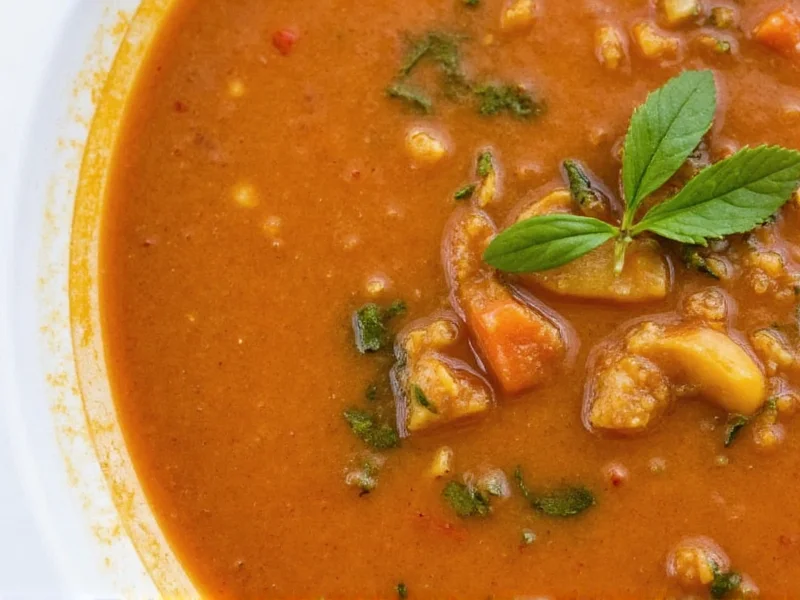West African palm soup represents one of Nigeria's most cherished culinary traditions, with variations spanning multiple ethnic groups including Igbo, Yoruba, and Efik communities. This nutrient-rich dish has sustained generations across the region, offering both nourishment and cultural significance. The authentic preparation method requires careful attention to ingredient proportions and cooking techniques passed down through families.
Understanding Authentic Palm Soup
True palm soup differs significantly from Western interpretations that might use hearts of palm as the primary ingredient. Nigerian palm soup centers around Elaeis guineensis oil—the vibrant red palm oil extracted from the fruit of the African oil palm tree. This unrefined oil contains natural carotenoids that give the soup its characteristic color and provides significant nutritional benefits including vitamins A and E.
When preparing traditional palm soup, cooks begin with fresh palm fruit bundles, which they boil and pound to extract the oil. Modern preparations often use pre-extracted red palm oil for convenience while maintaining authenticity. The soup typically includes a protein component such as goat meat, beef, fish, or periwinkles, along with bitterleaf vegetables, utazi leaves, and a complex spice blend that varies by region.
Essential Ingredients for Traditional Palm Soup
The foundation of any authentic Nigerian palm soup recipe rests on specific ingredients that create its distinctive flavor profile. While regional variations exist, certain components remain consistent across traditional preparations.
| Core Ingredients | Traditional Substitutes | Function in Recipe |
|---|---|---|
| Unrefined red palm oil | None (essential) | Base for soup, provides color and nutrients |
| Fresh bitterleaf | Dried bitterleaf (soaked) | Adds characteristic bitter note |
| Utazi leaves | Bitter leaf (additional) | Enhances bitterness and aroma |
| Assorted meats | Fish or seafood | Provides protein and depth of flavor |
| Pepper mix (scotch bonnet) | Cayenne pepper | Creates heat and complexity |
Step-by-Step Preparation Method
Creating authentic palm soup requires specific techniques that preserve the integrity of the ingredients while developing complex flavors. The traditional preparation process follows these essential steps:
- Prepare the palm oil - Heat unrefined red palm oil gently without frying to maintain its nutritional properties
- Cook proteins separately - Boil meats with onions and stock cubes until tender before adding to the soup
- Add bitter components - Incorporate washed bitterleaf and utazi leaves to achieve the signature flavor balance
- Season carefully - Add ground pepper mix and other spices without overwhelming the natural palm oil flavor
- Simmer gently - Allow flavors to meld over low heat for 20-30 minutes without boiling vigorously
Many beginners make the mistake of frying the palm oil too aggressively, which destroys its delicate flavor compounds and reduces nutritional value. The oil should merely be heated through, not cooked until it separates or darkens significantly.
Regional Variations Across West Africa
While Nigerian palm soup represents the most well-known version, neighboring countries have developed their own interpretations of this palm oil-based dish. These variations reflect local ingredients and cultural preferences while maintaining the essential palm oil foundation.
In Ghana, palm nut soup (abenkwan) incorporates ground palm nuts along with the oil, creating a thicker consistency. Cameroon's njama njama soup features bitterleaf more prominently and often includes crayfish for additional umami. The Delta region of Nigeria produces banga soup, which emphasizes fish and seafood components with a thinner broth.
Each variation maintains the core principle of balancing the natural bitterness of traditional African vegetables with the richness of palm oil and proteins. Understanding these regional differences helps appreciate palm soup's significance as a unifying culinary tradition across West Africa.
Nutritional Profile and Health Considerations
Red palm oil, the foundation of authentic palm soup, offers notable nutritional benefits when consumed in moderation. Unlike refined vegetable oils, unrefined palm oil contains:
- Naturally occurring vitamin E (tocotrienols)
- Beta-carotene (pro-vitamin A)
- Healthy saturated and unsaturated fats
- Antioxidants with potential health benefits
Traditional palm soup preparation methods preserve these nutrients better than high-heat cooking techniques. The inclusion of bitterleaf vegetables adds additional phytochemicals with potential digestive benefits. When prepared with lean meats and abundant vegetables, palm soup provides a balanced meal rich in protein, healthy fats, and micronutrients.
Serving Traditions and Cultural Significance
In Nigerian culture, palm soup represents more than just sustenance—it carries deep social and ceremonial importance. Families traditionally prepare palm soup for special occasions including weddings, naming ceremonies, and homecoming celebrations.
The soup is typically served with starchy accompaniments that help balance its rich flavor profile. Common pairings include:
- Fufu (pounded yam or cassava)
- Eba (garri soaked in hot water)
- Amala (yam flour paste)
- Usi (plantain fufu)
The method of eating also holds cultural significance—diners traditionally pinch off small portions of the starch, create an indentation with the thumb, and use it to scoop the soup. This communal style of eating reinforces social bonds and reflects West African hospitality traditions.
Modern Adaptations and Preservation of Tradition
As Nigerian cuisine gains global recognition, chefs and home cooks have developed contemporary interpretations of palm soup that maintain authenticity while accommodating modern lifestyles. These adaptations include:
- Pressure cooker methods that reduce preparation time while preserving flavor
- Vegetarian versions using mushrooms and plant-based proteins
- Freezer-friendly preparations for meal prepping
- Refined techniques for extracting palm oil at home
Despite these innovations, the essence of authentic palm soup remains unchanged—the harmonious balance of palm oil's richness, the distinctive bitterness of traditional leaves, and the depth of flavor from carefully selected proteins. Preserving these core elements ensures that palm soup continues to represent West African culinary heritage accurately.











 浙公网安备
33010002000092号
浙公网安备
33010002000092号 浙B2-20120091-4
浙B2-20120091-4